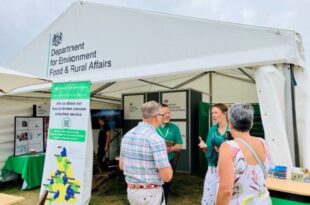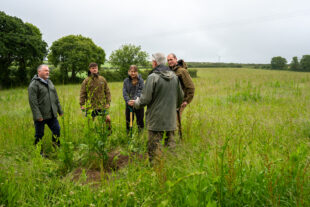https://defrafarming.blog.gov.uk/maintain-and-enhance-ponds-and-lakes/
Maintain and enhance ponds and lakes
The guidance on this page is for SFI pilot participants only. Please visit GOV.UK for the official Sustainable Farming Incentive scheme guidance.
Find out how land managers can keep ponds and lakes in good condition for wildlife.
If you’re completing this action as part of the Sustainable Farming Incentive pilot, how you do it is up to you.
The advice on this page can help you get better environmental and business benefits, but you do not have to follow it to get paid.
Why you should improve pond and lake habitats
Ponds and lakes are important habitats and can support a wide range of species. You can maintain and enhance them to increase wildlife diversity.
You can do this for ponds and lakes that are:
- in existing good condition
- newly created
- restored
Benefits of maintaining and enhancing ponds and lakes
Benefits include:
- better water quality
- less pond edge or lake shoreline erosion
- better habitats for native fish and other aquatic species
Improve water quality in ponds and lakes
Good water quality is essential for ponds and lakes. Finding where water enters your pond or lake can help you identify sources of pollution or nutrient runoff.
You must follow the farming rules for water. These require you to take steps to stop manure, fertiliser or soil getting into water bodies.
To improve water quality in ponds and lakes you can also:
- match fertilisers and organic manures to crop demand, to reduce risk of nutrient run off
- create and use a nutrient management plan
- manage surrounding grassland without adding nutrients
- change the way you manage grassland next to water
- use grass margins to help to intercept sediment, nutrients and pesticides
- control water levels when necessary
Before you start
If your land is part of a Site of Special Scientific Interest (SSSI), you must find out whether you need to get consent to manage your pond or lake.
If a pond is known to support rare species like great crested newts you’ll need to apply for consent. Check if you need a licence for work affecting other protected wildlife.
If any parts of a lake you manage are on a different land holding, try to agree a plan with neighbouring land managers.
How to maintain and enhance ponds
If you cannot restore a pond because of its conservation value, you can still enhance it. Watch how the pond develops and change your management actions if necessary.
Where you have several ponds, try maintaining different conditions in each. This could involve:
- leaving some ponds open and sunny and others shaded
- different depths of water in each pond
- allowing one or more ponds to dry up in summer
More variety will allow different species to colonise each pond.
Amphibians can move between ponds if you leave some bramble or scrub connecting them.
Manage vegetation at pond edge
Light grazing on unshaded areas of the pond edge will produce a variety of emergent plants. Allowing animals to graze the perimeter will create muddy margins. This will encourage a range of semi-aquatic vegetation around the pond.
Livestock trampling can make the water cloudy (turbid), with suspended soil particles or algae. You can prevent this by:
- using temporary fencing or controlled access around the pond
- maintaining suitable grazing numbers in spring and summer
Cut back young scrub every year if you cannot graze. Keep mature trees and hedgerows but remove new growth that is less than 50 years old to avoid dense shade.
Leave some scrub or bramble around the edge of the pond as a nectar source.
Manage pond plants
It’s best to manage pond plants in autumn and winter. This avoids disturbing breeding birds, amphibians and fish.
Where emergent plants cover more than 50% of the pond surface, you should remove some of them. If a single species like bulrush starts to dominate, remove it as soon as possible.
When removing plants:
- aim to leave approximately 20% of the emergent vegetation
- do not remove all the plants of any single species
- do not remove more than 10% of a pond’s marginal plants in any one year
When managing marginal plants, trees and scrub in a mature pond, keep to the pond’s original area and profile. Avoid enlarging or changing the pond edges.
Mature ponds that are full of emergent species already provide good habitat. Some careful plant removal can bring benefits but remove no more than 25% over a 3-year period.
Where you have more than one pond, manage them in different years to provide a range of conditions.
How to maintain and enhance lakes
Allow water levels to fluctuate naturally throughout the year. These changes create important areas of marginal habitat, which are usually underwater in winter but exposed in summer.
Lakes with structures that allow you to control water levels should be managed to copy the natural process of higher water levels in winter and lower levels in summer. Do not exceed the natural variation for the lake.
If your lake is naturally shallow, manage water levels carefully to prevent large areas drying out.
You can create artificial refuges or ‘floating islands’ with logs or mats of vegetation for tiny organisms (zooplankton), which attract birds and fish.
Leave submerged vegetation unless you’re removing invasive non-native species.
If the lake is used for recreation like boating, you can cut some submerged vegetation around boathouses or fishing pegs. Do not remove more than 20% of the total area of the lake vegetation.
Manage shoreline vegetation
Trees along a shoreline provide both food and habitats for invertebrates and fish as leaf litter and insects fall into the water. Avoid too much shade as it can restrict the growth of aquatic plants.
Aim for a shoreline with a mix of full shade, dappled shade and open areas. The benefits of shade include:
- cooling the water which can help counter the effects of climate change
- limiting wind and wave action, reducing shoreline disturbance
Shoreline management could include:
- periodic cutting of some shoreline trees or scrub to maintain good areas of marginal vegetation
- removing trees, particularly where there are declines in marginal vegetation
- occasional grazing to prevent shoreline vegetation becoming too rank
Manage fish and fishing
If the lake already contains native fish, manage any existing angling interests to prevent:
- damage to bankside and shoreline vegetation
- nutrient levels rising due to baiting
Avoid restocking if there are no or few fish already in the lake. Fish affect other species by:
- competing with them for food
- changing or damaging the existing habitat
Common carp are particularly bad for a lake as they can:
- damage the vegetation
- increase the nutrient levels
- disturb the sediment creating turbid water
Where possible you should remove them as part of a lake restoration programme.
Avoid spreading invasive non-native species
Some non-native plants and animals, known as invasive non-native species (INNS), can:
- colonise ponds and lakes
- alter the habitat
- outcompete native species
Find out which plant species and which animal species you should look out for.
Practice good biosecurity around ponds and lakes to avoid spreading INNS to another water body. You should:
- clean machinery, tools and footwear before and after visiting each site
- keep access to a minimum
- prevent dogs from entering the ponds and lakes
Find out more about biosecurity.
What well-managed ponds and lakes look like
You’ll see a greater range of animals, like:
- amphibians
- insects like damselflies and water beetles
- water birds and mammals
Ponds
There’ll be a variety of ponds within the landscape, including:
- ponds of various sizes and depths with good water quality
- ponds with clear, clean water
- open ponds that support a range of aquatic plants
- a variety of open and shaded ponds, with deep and dappled shade
Lakes
Lakes will display:
- good clear, clean water
- a wide range of emergent and submerged plants
- conditions that encourage diverse wildlife like amphibians, water birds and insects
- natural variations in water level



